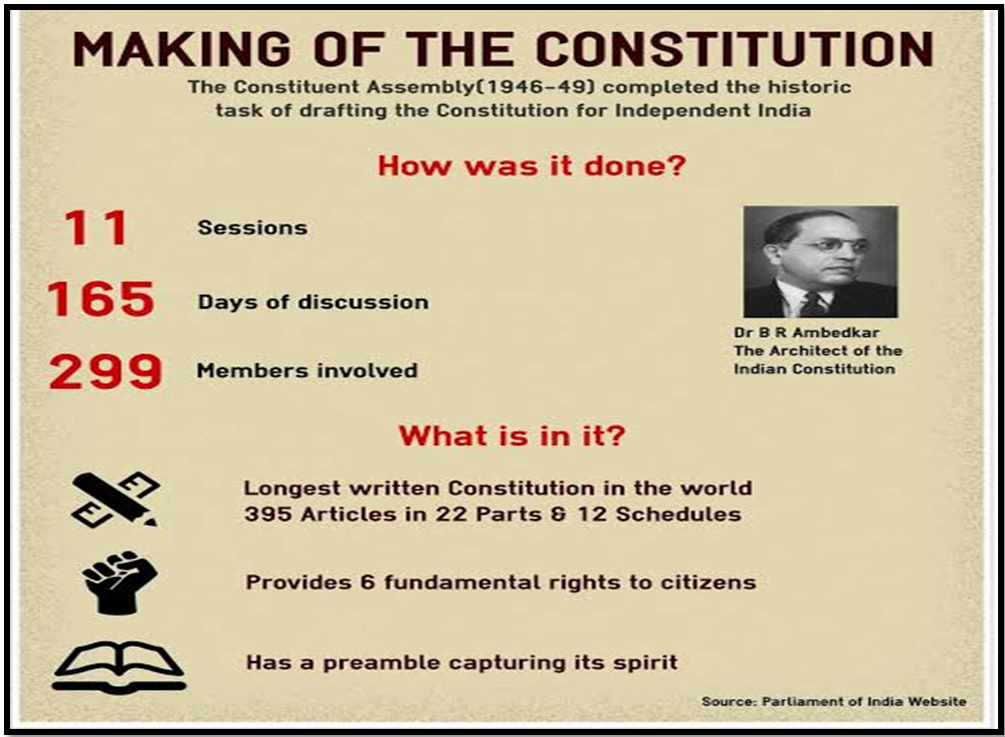OUR FREEDOM, OUR CONSTITUTION
Syllabus:
GS 2:
- Indian Constitution—Historical Underpinnings and Evolution
Focus:
The significance of the Indian Constitution has been recently highlighted as the nation reflects on its role in shaping modern India. As India marks over 75 years of Independence, discussions around the Constitution’s origins, public participation in its making, and its enduring relevance have resurfaced, reaffirming its importance as a living document.
Source: Factly
Historical Underpinning:
- Constitutional Ownership: As the tricolour was hoisted on August 15, 1947, Indians collectively embraced the Constitution-in-the-making, viewing it as a tool for transforming their lives and rights.
- Early Criticism: Shortly after Independence, the draft Constitution faced criticism for its length, with some suggesting a shorter document to better evoke emotional and national sentiment.
- Final Constitution: Despite its length, the 1950 Constitution became a powerful symbol and rallying point, deeply resonating with the Indian public and remaining relevant in daily life.
- Public Engagement: From its inception, the Constitution was a site of struggle, with citizens actively asserting their rights and influencing its formation through diverse demands and expectations.
- Nationwide Involvement: Across India, various groups and individuals passionately engaged with the Constitution-making process, contributing to its development and pushing for inclusive rights.
Public’s Role in Constitution-Making
- Innovative Claims: Public involvement led to innovative rights claims, addressing issues like disability, sexual violence, child rights, and the right to food, reflecting their daily life experiences.
- Adivasi Contribution: For instance, Adivasi Gond students convened a conference and sent demands to the Constituent Assembly, advocating for education, employment, and representation.
- Unexpected Participation: The widespread public engagement was unplanned, surprising the Constituent Assembly, which had initially considered holding debates behind closed doors.
- Demand for Inclusion: The public’s insistence on participation forced the Assembly to open up the process, leading to the circulation of the draft Constitution for public comment and widespread translations.
- Ownership of the Process: Through their engagement, the Indian public critically analyzed the draft, demanding changes and ensuring the Constitution’s implications aligned with their aspirations.
Constitutional Struggles and Rights
- Demanding Rights: Groups like the Deaf and Dumb Society of India highlighted the need for specific constitutional guarantees, emphasizing that universal adult franchise alone was insufficient.
- Focus on Inclusion: These demands underscored the need for education, employment, anti-discrimination measures, and inclusion in the census to ensure true equality under the Constitution.
- Public’s Active Role: Despite challenges like illiteracy and poverty, the Indian public was not passive; they actively shaped the Constitution through collective struggles and demands.
- Constitutional Understanding: The public understood the significance of the Constitution and saw themselves as key players in its creation, rather than mere recipients of its provisions.
- Transformation Through Rights: For the Indian public, the Constitution was a living document, central to their vision of transforming social, economic, and political life in post-Independence India.
| What is Constitutionalism?
Constitutionalism is the principle that governs the legitimacy and authority of a government, ensuring that power is exercised within legal and institutional boundaries. It emphasizes the protection of individual rights, the separation of powers, and the accountability of government officials. Constitutionalism serves as a safeguard against arbitrary rule, ensuring that governance is conducted according to established laws and principles, rather than the whims of those in power. |
Tryst with Constitutionalism
- Pre-1950 Constitutionalism: Indians became constitutionalists even before the Constitution came into force, actively engaging with its creation and implications.
- Collective Imagination: The process of Constitution-making captured the public’s imagination, with citizens understanding and actively participating in shaping their future.
- Transformative Vision: The public reimagined freedom as a comprehensive transformation of their lives, aligning social, economic, and political aspirations with the Constitution.
- Persistent Pursuit: Since the Constitution’s inception, Indians have persistently pursued their vision of freedom, continuously engaging with and interpreting the document.
- Constitution as Freedom: The Indian public’s engagement ensured that the Constitution became a true representation of their aspirations, embodying their collective vision of freedom and rights.
Constitution as a Living Document
- Beyond Sacred Text: The Indian public viewed the Constitution not as a sacred or static text but as a dynamic instrument to be interpreted and acted upon by ordinary citizens.
- Ownership and Action: Indians took ownership of the Constitution even before it came into force, using it to reimagine and reshape their freedom in all aspects of life.
- Persistent Mobilization: Throughout the Constitution-making process and beyond, Indians have persistently mobilized to pursue their transformative vision of freedom and rights.
- Empowerment Through Constitution: The public’s engagement with the Constitution has empowered them to challenge injustices and assert their rights, making the document truly theirs.
- Living Constitution: As the Indian public demonstrated, the Constitution is a living entity, continuously evolving and responding to the aspirations and struggles of the people.
Conclusion
The Indian Constitution is not merely a legal framework but a testament to the active participation and aspirations of the Indian public. From its inception, it has served as a powerful tool for social, economic, and political transformation, continuously evolving to meet the needs of its citizens. The Constitution remains central to India’s democratic ethos and the pursuit of justice, equality, and freedom.
Source:India Express
Mains Practice Question
Discuss the role of public participation in the making of the Indian Constitution and its impact on the document’s relevance in contemporary India. How has this engagement shaped the evolution of constitutional rights and freedoms? (250 words)
Associated:
https://universalinstitutions.com/category/mains-capsule/gs-2-mains-capsule/indian-polity/page/3/




